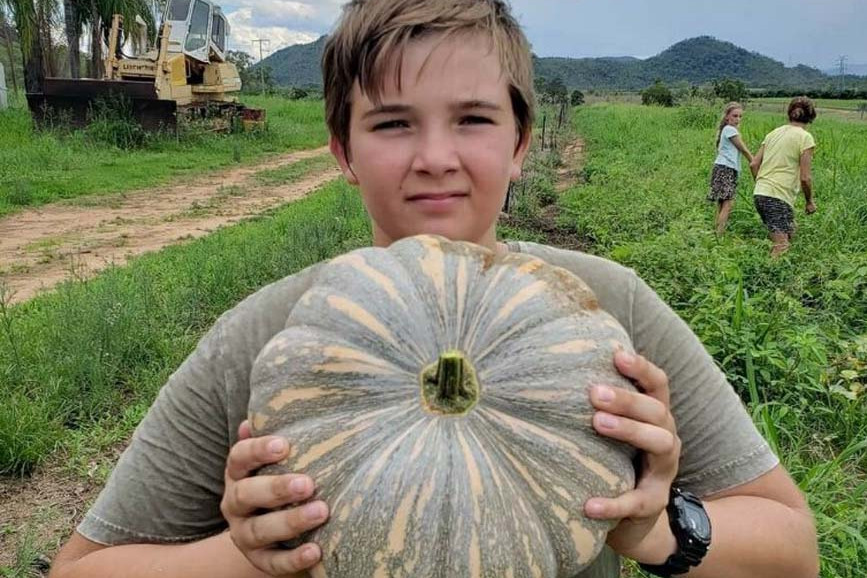On The Land
18 June, 2024
Pumpkins reign supreme on Tablelands
THE Tablelands’ rich volcanic soil and favourable climate provide ideal growing conditions for pumpkins which have been named as the 2024 QCWA Primary Product of the Year.

Mareeba pumpkin grower Angela Nason, who is involved in her family’s farming operation, said her father, Charlie Price, started growing pumpkins nearly three decades ago.
“Pumpkins were chosen for their versatility and popularity in the market,” Angela said.
“They are used in a wide range of culinary dishes and have a steady demand, making them a reliable crop. They also provide a steady source of income.
“We've grown Queensland Blue and Jap/Kent varieties. Jap pumpkins, which share the same name as Kent pumpkins, have been a staple crop on the Tablelands for generations.
“The Jap variety is easier to grow and experiences greater demand due to its smaller size, which is preferred by most customers.”
Angela said the key factors which contributed to a successful harvest included selecting the right soil, managing water and nutrients, and protecting the crop from pests and diseases.
Regular monitoring and timely interventions were crucial for a successful harvest.
Common pests which are encountered include aphids and squash bugs and diseases like powdery mildew and downy mildew are also challenges.
“We manage pests and diseases through a combination of crop rotation, pesticides and maintaining healthy soil,” Angela said.
“Regular inspections help catch issues early.”
Angela said her family’s farm planted pumpkins in the spring for a late summer to early autumn harvest.
“We primarily focus on one major growing season to align with market demand,” she said.
“Harvest typically occurs from late August to October, but we've put in smaller crops at different times of the year to supply the local market almost all year round.”
Their farm produced several tonnes of pumpkins annually, although the exact amount varied with each season.
“The Tablelands region collectively produces thousands of tonnes of pumpkins each year, supplying both local and regional markets,” Angela said.
“Prices range between 80 cents to $1.50 per kilo, depending on market conditions, supply and demand.
“Most of our pumpkins are sold locally, but over the years we've also supplied to regional markets.
“However now, we are just concentrating on the local market and supplying my company, Tablelands to Tabletop, where they can be purchased.
“The Tablelands region generally produces enough pumpkins to meet local demand.
“Occasionally, pumpkins from other regions supplement local supply during high-demand periods.
“Challenges include managing pests and diseases, unpredictable weather, and maintaining soil fertility.
“So, we use integrated pest management, weather monitoring systems and soil testing to mitigate these issues.
“Pumpkins are great for crop rotation (with tomatoes, navy beans, onions and potatoes) helping to manage pests and diseases, break disease cycles and improve soil health.
“There is potential for growth in the market, especially with increasing demand for local produce and niche varieties.”
Initial costs can be significant, including land preparation, seeds, irrigation systems and pest management. However, with proper planning and management, pumpkin farming can be profitable.
“Start small, learn from experienced growers, and focus on soil health and pest management,” Angela said.
“Diversify your crops and explore different market opportunities.”
Pumpkins are rich in vitamins A and C, fibre, and antioxidants, making them a healthy addition to any diet.
The popularity of Jap pumpkins can be attributed to their sweet, nutty flavor and smooth texture, which makes them perfect for a wide range of culinary creations.
“A pumpkin festival would be a great idea for the Tablelands,” Angela said.
“Pumpkin farming is not only a business but a way of life for our family.
“It is a family tradition started by my father, Charlie. It's rewarding to continue this legacy and contribute to our community's agricultural heritage.
“We are proud to contribute to our community's food supply and enjoy the connections we make with our customers through our pumpkins.”


